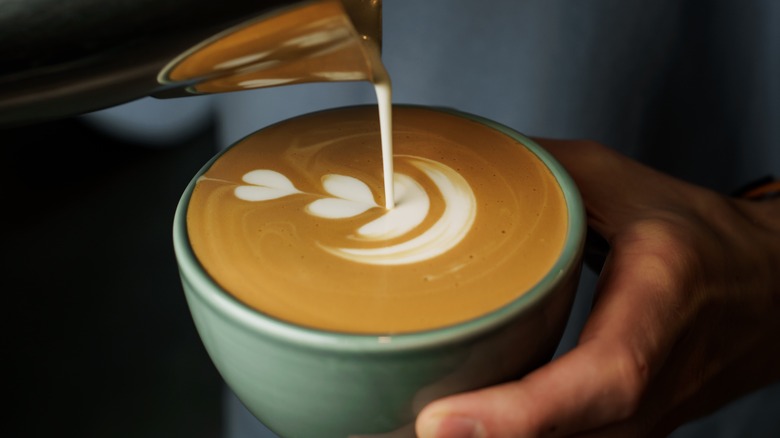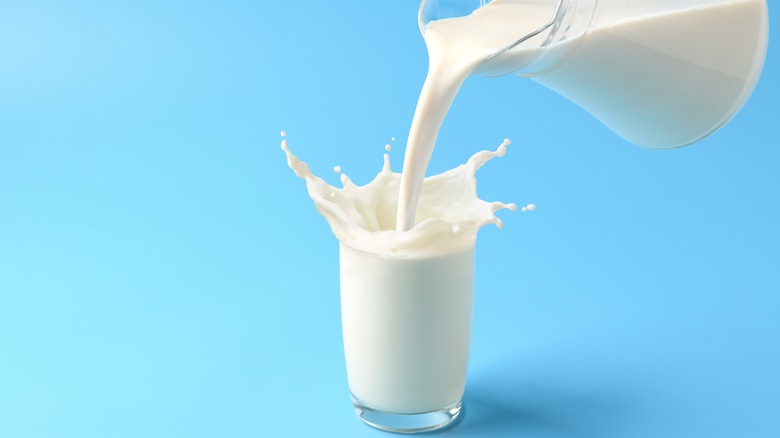The Worst Milk To Use When Attempting Beautiful Latte Art, Per A Barista
Latte art is, in some ways, the final frontier when it comes to brewing espresso at home. After amateur baristas nail the espresso pull (or the button push on an instant machine), they're left facing down the milk steamer. A latte will taste good no matter how it's presented, but since we eat with our eyes, a beautiful bit of foam art can elevate the experience.
It takes practice to get the hang of a perfect pour, but it helps to set your station up for success. Food Republic spoke with Coffee and Tea Specialist Jee Choe for her advice. She shared the trickiest type of milk to use for latte art: "The worst milk to use is one that's close to the expiration date and that has [a] low fat content, like almond milk. The microfoam it creates won't be as consistent."
This effect is exacerbated by other common mistakes newcomers might make, like overheating, which can cause curdling or souring. If your dairy is already less-than-fresh, this will highlight the change in smell that occurs as it ages. Over-aerating makes a less creamy foam and will produce a voluminous fluff that makes the froth harder to work with.
Fat gives microfoam a boost
Believe it or not, there are actually multiple types of foam paired with espresso. There's the dry fluff, typically found at old-school Italian cafes atop cappuccinos, called macrofoam. And then there's the glossy layer found at third-wave coffee shops called microfoam. The former is made up of large bubbles, and the latter is made of teeny-tiny, pourable bubbles that are ideal for latte art.
Microfoam is wetter than its macro counterpart, and its meringue-like consistency makes it better suited for easing into hot espresso. Dry foam, aka macrofoam, which is similar to a stiff egg white, tends to clump and plop into a drink. Although there are benefits to whipping up a dry cappuccino, the milk's inflexibility will make artful designs very tough. Plus, drinkers lose out on the velvety texture of the microfoam and the blending of sweet, soft bubbles and fresh espresso.
Using reduced or nonfat milk is more likely to produce this dry foam because the milk's proteins are trying to escape the moisture injected by the steam wand, rather than form a creamy emulsion. Fat encourages the formation of bubbles coated in fat, producing the silky microfoam baristas are after. Beginners should opt for higher-fat options (2% or whole milk) or non-dairy options formulated for baristas to see what they're capable of.
Why freshness impacts latte foam
Whether you're breaking out high-end equipment or zapping shaken dairy in the microwave to make foam, age can impact the bubbles. It helps to keep track of not only the expiration date but also the date you opened the milk. Opened oat milk stays fresh for about 10 days, and opened almond milk lasts about the same amount of time.
That's because as the products age, they will change in texture and become chunky or slimy. Since soy milk in particular is already inclined to clump when foamed, this serves to maximize the effect. The taste may change as the cartons get older, too, ultimately resulting in a funky consistency and unpleasant drinking. Many non-dairy milks, like almond, will naturally separate, which could pose a further challenge as home baristas try to emulsify the liquid when steaming.
Even cow's milk has issues as it gets old. A phenomenon called lipolysis can occur in milk that's left to sit out or warm for too long. This results in enzymes starting to break down the lipids in the liquid. As the fat content decreases, the fresh milk loses its ability to form smooth microfoam and expired milk likely won't froth at all.



